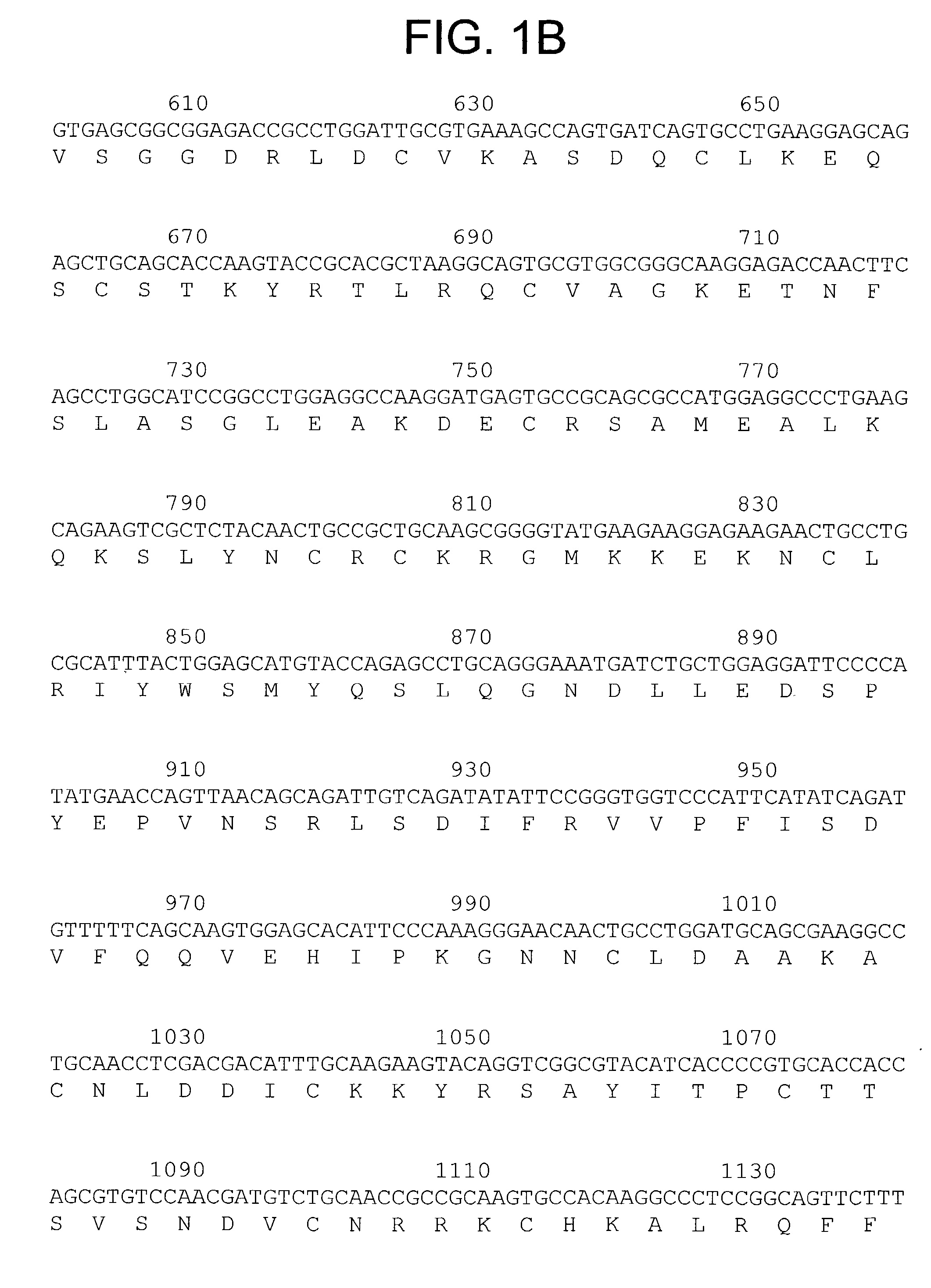Glial cell line-derived neurotrophic factor receptor
a neurotrophic factor and receptor technology, applied in the direction of dna/rna fragmentation, peptide/protein ingredient, depsipeptide, etc., can solve the problems of not being able to survive in culture medium, and the mode of action of gdnf in vivo is not clearly elucidated
- Summary
- Abstract
- Description
- Claims
- Application Information
AI Technical Summary
Benefits of technology
Problems solved by technology
Method used
Image
Examples
example 1
Identification of Cells Expressing High Affinity GDNF Binding Sites
[0217] Expression cloning involved the selection of a source of mRNA which is likely to contain significant levels of the target transcript. Retina photoreceptor cells were identified as responsive to GDNF at very low concentrations, suggesting the existence of a functional, high affinity receptor. To confirm that rat photoreceptor cells did express a high affinity receptor for GDNF, [.sup.125I]GDNF binding and photographic emulsion analysis were carried out.
[0218] Rat Retinal Cell Cultures
[0219] The neural retinas of 5-day-old C57B1 / 6 mouse pups or 3-day-old Sprague-Dawley rat pups (Jackson Laboratories, Bar Harbor, Mass.) were carefully removed and dissected free of the pigment epithelium, cut into 1 mm.sup.2 fragments and placed into ice-cold phosphate-buffered saline (PBS). The retinas were then transferred into 10 mL of Hank's balanced salt solution (HBSS) containing 120 units papain and 2000 units DNAase and in...
example 2
Expression Cloning of a GDNFR from Photoreceptor Cells
[0227] Rat photoreceptor cells were selected as a possible source of a high affinity receptor for GDNF based upon their cell surface binding of radiolabeled GDNF and their ability to respond to very low concentrations of the ligand, as described in Example 1. In order to identify the receptor, a size-selected cDNA library of approximately 50,000 independent clones was constructed using a mammalian expression vector (a derivative of pSR, Takebe et al., 1988 supra) and mRNA isolated from cultured post-natal rat photoreceptor cells, by the methods described below. The library was divided into pools of approximately 1,500 to 2,000 independent clones and screened using an established expression cloning approach (Gearing et al., EMBO Journal, 8, 3667-3676, 1989). Plasmid DNA representing each pool of the library was prepared and transfected into COS7 cells grown on plastic microscope slide flaskettes (Nunc, Naperville, Ill.).
[0228] The...
example 3
DNA Sequencing and Sequence Analysis
[0237] DNA from positive, single clones was prepared and sequenced using an automated ABI373A DNA sequencer (Perkin / Elmer Applied Biosystems, Santa Clara, Calif. ) and dideoxy-dye-terminators, according to manufacturer's instructions. Comparison of GDNF receptor sequence with all available public databases was performed using the FASTA (Pearson and Lipman, Proceedings Of The National Academy Of Sciences U.S.A., 85, 2444-2448, 1988) program algorithm as described in the University of Wisconsin Genetics Computer Group package (Program Manual for the Wisconsin Package, Version 8, September 1994, Genetics Computer Group, Madison, Wis.).
[0238] Sequence Characterization of the Rat GDNFR
[0239] Plasmid DNA from the clones described in Example 2, above, was prepared and submitted for DNA sequence analysis. Nucleotide sequence analysis of the cloned 2138 bp rat cDNA revealed a single large open reading frame encoding a translation protein of 468 amino acid ...
PUM
| Property | Measurement | Unit |
|---|---|---|
| pH | aaaaa | aaaaa |
| pH | aaaaa | aaaaa |
| temperature | aaaaa | aaaaa |
Abstract
Description
Claims
Application Information
 Login to View More
Login to View More - R&D
- Intellectual Property
- Life Sciences
- Materials
- Tech Scout
- Unparalleled Data Quality
- Higher Quality Content
- 60% Fewer Hallucinations
Browse by: Latest US Patents, China's latest patents, Technical Efficacy Thesaurus, Application Domain, Technology Topic, Popular Technical Reports.
© 2025 PatSnap. All rights reserved.Legal|Privacy policy|Modern Slavery Act Transparency Statement|Sitemap|About US| Contact US: help@patsnap.com



